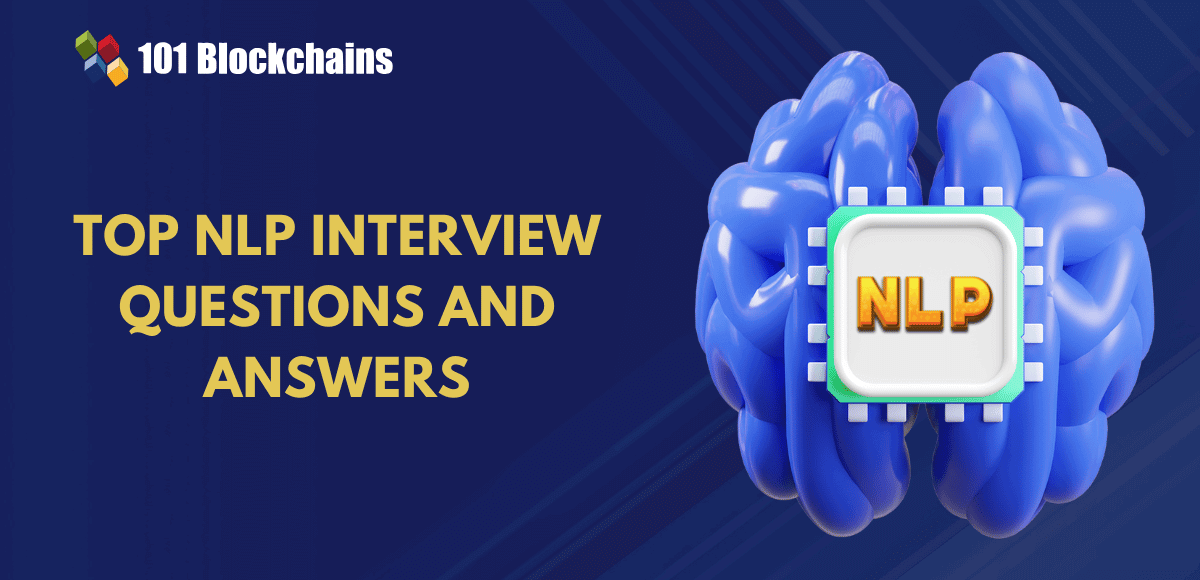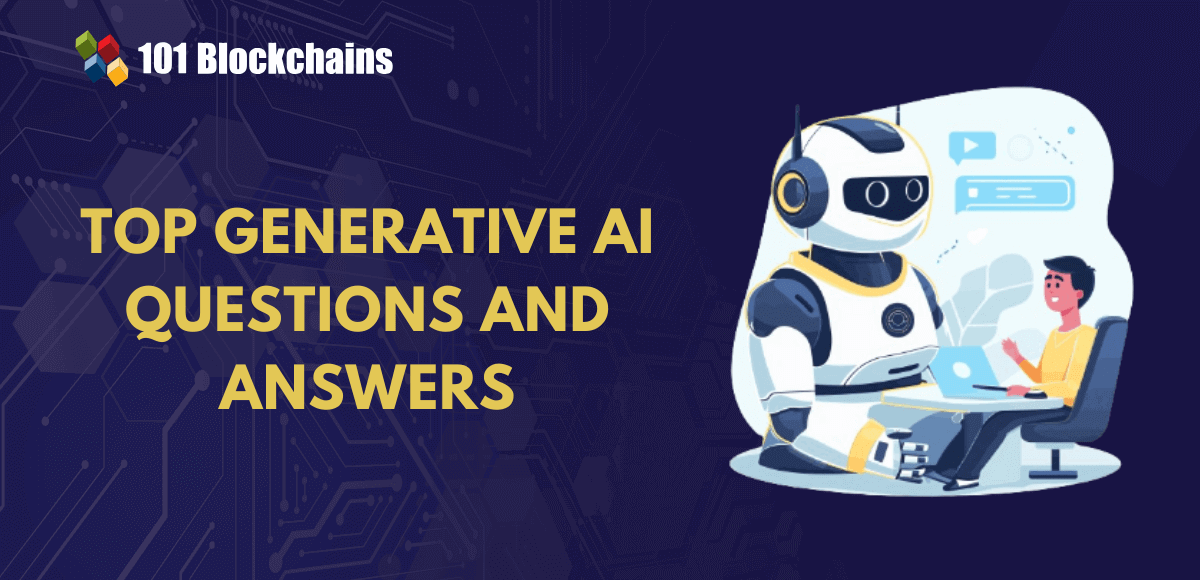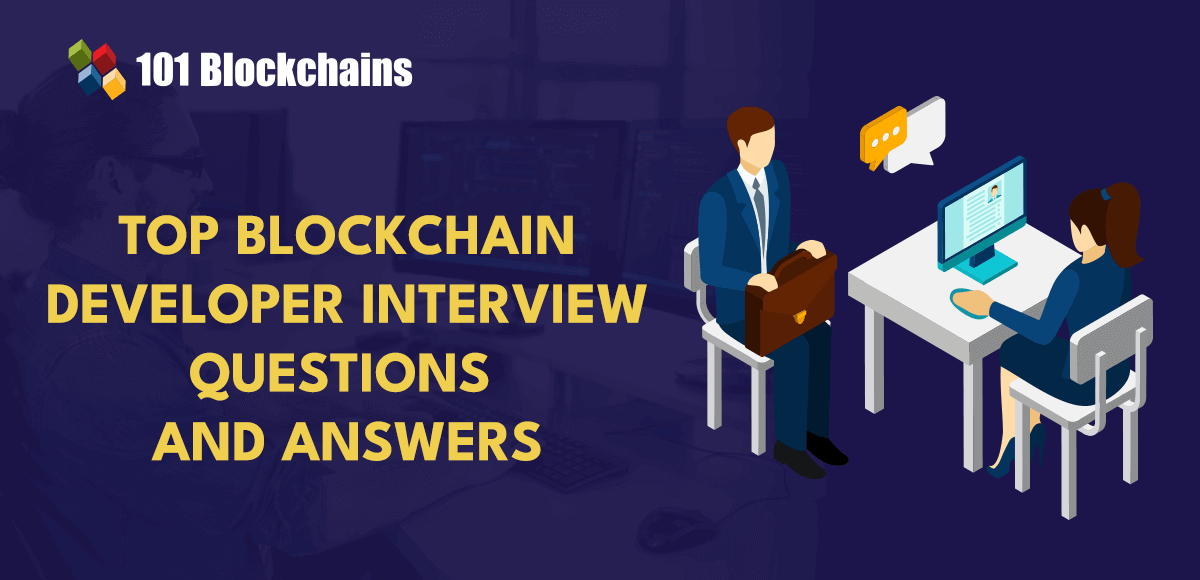Learn how blockchain truly works, master key definitions, and uncover what makes smart contracts so "smart." Dive into the fundamentals, gain valuable insights, and start your blockchain journey today!
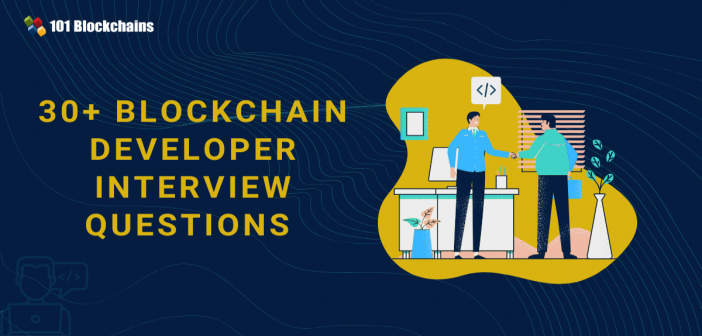
- Interview Preparation
Georgia Weston
- on January 07, 2025
30+ Blockchain Developer Interview Questions in 2025
Are you looking for the most frequently asked Blockchain Developer interview questions? If you do, then you have come to the right place!
Blockchain is by far one of the most revolutionary technologies of the 21st century. Furthermore, it is often stated as the second coming of the internet and is predicted to disrupt and reshape how we do business worldwide.
84% of companies are trying to incorporate Blockchain technology into their operations. As such, you can imagine the growing demand for blockchain developers. Analysts have predicted that the blockchain market is expected to grow from USD 1.2 billion in 2018 to USD 23.3 billion by 2024.
Considering all this, today is the perfect time to land your dream job as a blockchain developer. We prepared a list of blockchain developer interview questions to get you prepared.
Getting Ready For A Blockchain Developer Interview
Also, here are some tips and tricks that you should add to your Blockchain Developer interview questions preparation to ensure you get chosen for the post.
Research the Company:
Almost every company is looking for candidates that can fit in with their work environment and share the company’s goals and visions. As such, you need to do some research to understand the company you are applying to. This includes information on:
- Company launch date.
- The journey of the company.
- The size of the company.
- Recent press reports shared with the company include information linking to joint ventures, product launches, new advertising measures, and so on.
- Company culture.
Focus on the relevant skills important to the post:
You might have years of experience and tons of unique skill sets. However, since you are applying for a Blockchain interview, make sure you are representing skills that matter.
Furthermore, if you need to show your other achievements that are not related, then either create a separate column in your CV or wait for the interviewer to ask you specifically.
Build your identity as a certified blockchain expert with 101 Blockchains’ Blockchain Certifications designed to provide enhanced career prospects.
Prepare for the generic interview questions:
All interviews come with a couple of staple questions that we all have come to expect from HR. As such, make sure you have some good answers to these questions:
- Tell me about yourself.
- Where do you see yourself five years from now?
- Why did you choose a career in blockchain?
- What are your strengths?
- What are your weaknesses?
- Why did you choose this company?
- What is the source of your motivation?
- Tell me about your long-term career plans.
Not sure how to build your career in enterprise blockchains? Enroll Now in How to Build Your Career in Enterprise Blockchains Course
Present your best self:
We all know the saying – “first impression is the last impression.” As such, make sure you head into that interview room, being the best version of yourself.
- Dress well, rather dress professionally.
- Mind your body language. Sit straight with your hands visible to the interviewer.
- Think about the questions for a bit and then give your answers.
- Don’t exude negativity. Don’t talk negatively and put down previous employers
Now, that you are ready for the blockchain developer interview, let’s check out the 30+ blockchain interview questions.
Please include attribution to 101blockchains.com with this graphic. <a href='https://101blockchains.com/blockchain-developer-interview/'> <img src='https://101blockchains.com/wp-content/uploads/2020/05/Blockchain-Developer-Interview.png.webp' alt='blockchain developer interview questions='0' /> </a>
30+ Most Frequently Asked Blockchain Developer Interview Questions
Here is a list of the most common and tricky interview questions for a blockchain developer position. Furthermore, we recommend that you not just straight out remember them, but take time to understand them to make sure you have a clear and detailed understanding of the concepts.
1. What is blockchain?
Blockchain is an immutable decentralized digital ledger technology that can be programmed to hold transactional records with a focus on transparency as well as security.
The transactional records are referred to as “blocks” which are linked or “chained” together using cryptography.
2. What is the difference between the Bitcoin blockchain and Ethereum blockchain?
Bitcoin is basically a decentralized digital currency that you can use as a medium of exchange for financial transactions. It is like a digital dollar.
Ethereum, on the other hand, is a ledger technology that allows users to create new programs. However, it also comes with its coin value known as Ether which is compared to Bitcoin and can be used for improving financial transactions.
Excited to learn the basic and advanced concepts of ethereum technology? Enroll Now in The Complete Ethereum Technology Course
3. What are the different types of blockchains?
Broadly speaking, there are four different types of blockchains.
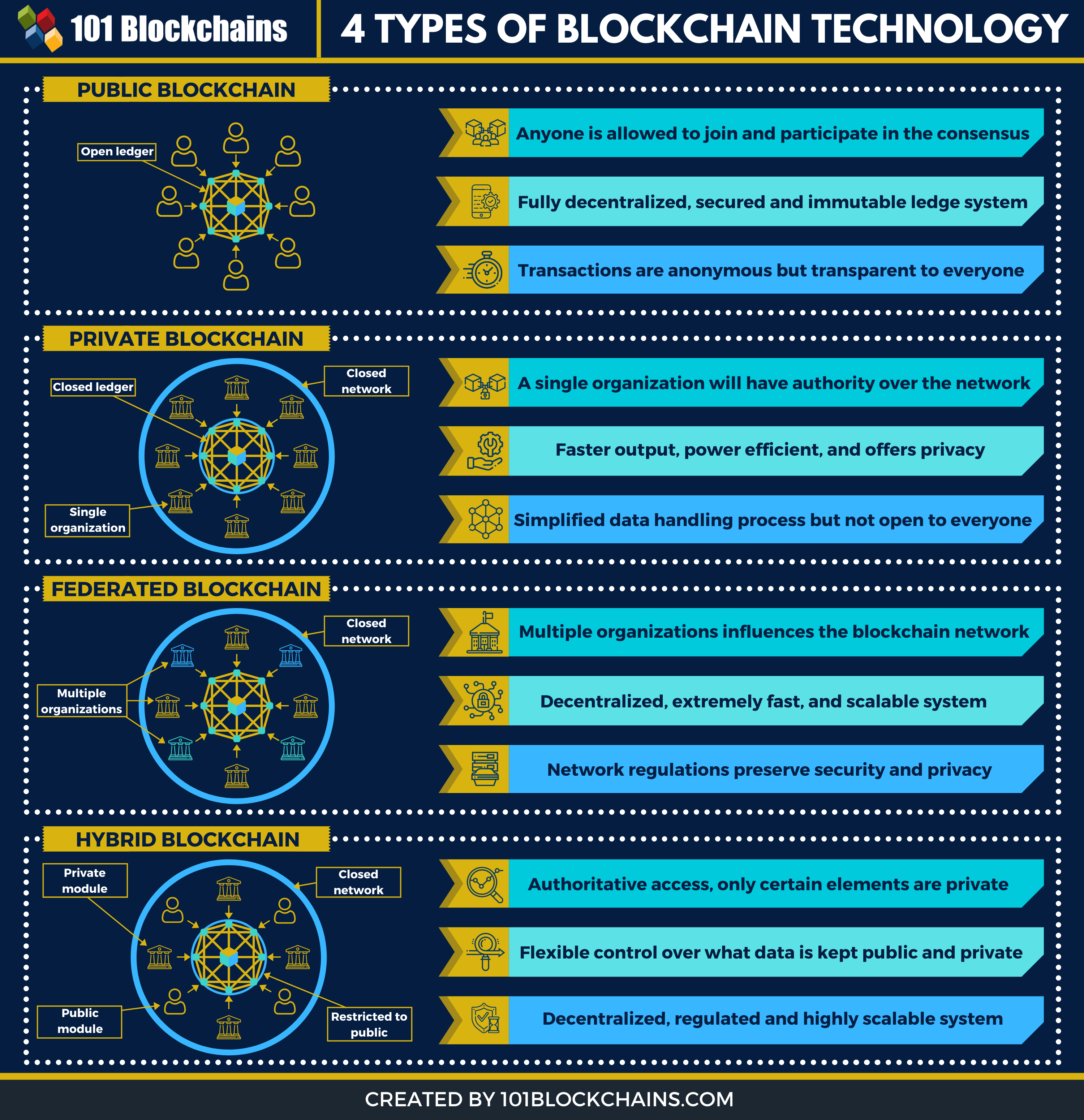
Please include attribution to 101blockchains.com with this graphic. <a href='https://101blockchains.com/blockchain-infographics/'> <img src='https://101blockchains.com/wp-content/uploads/2020/04/Types-of-Blockchain-Technology.png' alt='Types of Blockchain Technology='0' /> </a>
Public Blockchain: Public Blockchains are open-source and allow anyone to participate as developers, miners, and users. Furthermore, these are fully transparent allowing anyone to examine all recorded transactional information.
Private or Permissioned Blockchain: As the name suggests, Permissioned Blockchains impose certain privacy rules. For example, users require consent before participating in a network. Furthermore, all transactions remain private to the outside and only available to people inside the ecosystem.
Consortium Blockchain: Consortium Blockchain can be considered as a subcategory of the private blockchain. Furthermore, it comes with the same merits of a private blockchain but with the added clause that these are governed by a group rather than a single entity.
Hybrid Blockchain: Hybrid Blockchains offer the perfect blend between privacy and transparency, by utilizing aspects of both private and public blockchains. Furthermore, this is most popular among businesses as they can control what data they want to make public, and what data they want to keep private.
Start your blockchain journey Now with the Enterprise Blockchains Fundamentals
4. What is the principle on which blockchain technology is based?
At the core, the main principle is decentralization. Apart from that, it also aims to provide equal opportunity to everyone within the network. Bitcoin did succeed in doing so. However, the other types of blockchain technology may differ in their approach.
5. What is distributed ledger technology?
A distributed ledger, or distributed ledger technology, is basically a database that exists simultaneously across multiple locations. Furthermore, all data is distributed, replicated, and synchronized amongst these locations. It lacks a centralized data storage body or administrator.
6. What is the difference between distributed ledger technology and blockchain?
Blockchain is basically a type of DLT or digital ledger technology. That is to say, all blockchains are DLTs but not all DLTs are blockchains.
Blockchain basically adds an extra set of features to DLTs. Furthermore, with blockchain, all data is shared between all participants and is secured using a cryptographic signature, called a hash. This makes the information stored in the blockchain immutable, therefore enhancing security and integrity.
Want to learn about the difference between blockchain and distributed ledger? Read here about the difference between Blockchain and Distributed Ledger.
7. How blockchain can lead to more trust?
Blockchain is designed such that none of the stored information or records can be manipulated or even destroyed. Furthermore, blockchain facilitates transparency and removes a single governing regulatory body.
This gives users equal access to information, but without worrying about security violations as everything can be scrutinized by anyone.
8. What type of records are present in the blockchain’s database?
There are two types of records that can be stored inside a blockchain database:
- Transactional records.
- Block records.
9. What are the features of blockchain?
The main features that blockchain brings to the table include:
- A decentralized system.
- Distributed ledger.
- Safe and Secure Ecosystem.
- Minting.
Aspiring to make a lucrative career as a blockchain developer but not sure how? Check the detailed guide Now on How To Become Blockchain Developer?
10. What is encryption and what is its role in blockchain?
In reality, encryption is the process of encoding information, where the original information is changed so that other parties can’t understand it. The owner can still access the information by decrypting it using a given key.
In the case of blockchain, everyone has access to all the data, and information. This is where you can use encryption to make sure others can’t see a person’s personal data, thereby enhancing the security of the system.
11. What does “block” refer to in blockchain?
A block is a piece of transactional record or data that is stored in the blockchain database. These blocks are then linked together, thereby the name – blockchain.
Note: This is one of the commonly asked blockchain interview questions.
12. Is data written in a blockchain immutable?
Yes, data written in the blockchain is practically immutable.
As you know, the data stored in the blockchain are known as blocks. Each block is paired with a hash value. Now, each block not only contains a hash value for itself; but also the hash value of the preceding block. If any alteration is made to the block, then it will change the hash value.
Therefore, if you want to tamper with data on a single block, then you will have to change the entire blockchain, which is practically impossible.
Note: This is one of the commonly asked blockchain developer interview questions.
13. What is the difference between “proof of stake” and “proof of work”?
Proof of Work: Proof of Work is the process where miners compete to solve complex cryptographic puzzles, by investing massive computational power using high-end hardware and a ridiculous amount of energy consumption.
In return, the miner who solves the problem is given a token.
Proof of Stake: Proof of Stake is an alternative to Proof of Work, where there is no direct competition between the miners, and someone is randomly chosen to “validate” a block. The probability of becoming validator increases depending on how much stake you have in the blockchain i.e. how many tokens of the blockchain you own.
This helps minimize the use of expensive resources and thus is a much more environmentally friendly option.
14. What are block identifiers?
A block within a blockchain can be identified using the block header hash and the block height.
15. How do Merkle trees play an important part in blockchain?
A Merkle Tree is a data structure similar to a binary tree and is used to contain the cryptographic hashes of each block in a blockchain. Here the leaf node presents a hash of a block of transactional data whereas the non-leaf node represents a hash of the having leaf node.
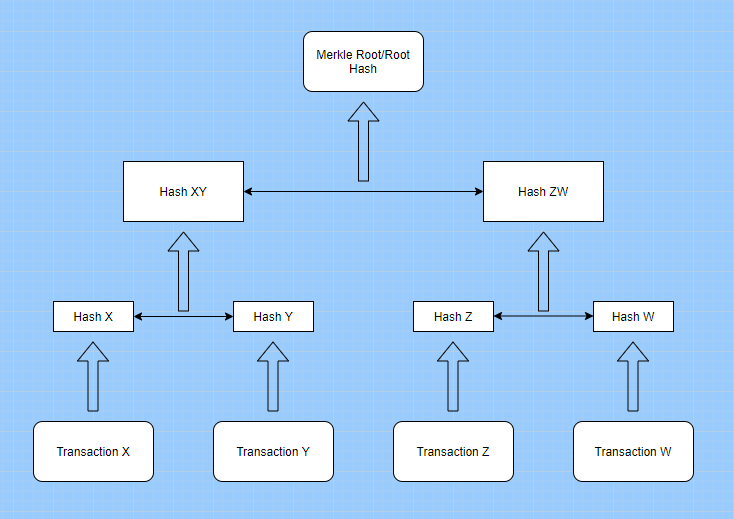
Merkle Tree Example
Please include attribution to 101blockchains.com with this graphic. <a href='https://101blockchains.com/merkle-trees/'> <img src='https://101blockchains.com/wp-content/uploads/2020/05/2-self-created-example-merkle-tree.png.webp' alt='merkle trees='0' /> </a>
The advantage of using the Merkle Tree structure allows users to simply download the chain of block headers, instead of downloading every single transaction and block. As such, this makes verifying the existence of a particular block inside a blockchain extremely easy and convenient.
16. What are the common types of Ledger that can be used in Blockchain?
The most common types of ledgers that can be used in blockchain include:
- Centralized networks.
- Decentralized networks.
- Distributed networks.
17. What is a Trapdoor Function in Blockchain development and what is its use?
In reality, a Trapdoor Function is a function that is easy to compute in one direction but difficult to compute in the opposite direction unless the user has access to special information.
The trapdoor function is crucial when developing public-key encryptions and you can use its in blockchains to create addresses and private keys for the users.
18. Why does a blockchain need tokens to operate?
You can use coins or tokens in the blockchain to implement changes between states. Anyhow, every transaction within a blockchain refers to a change of state which you can represent as moving a coin from one address to another address.
Apart from this, coins and tokens also facilitate transactions in the blockchain. Each transaction means there is a change of state which is represented by a change in data. Now tokens and coins are currently the only way to change the state of a block in an immutable blockchain.
Curious to learn about blockchain implementation and strategy for managing your blockchain projects? Enroll Now in Blockchain Technology – Implementation And Strategy Course!
19. How does peer discovery work in a P2P network?
When a new node boots up, it has no information about the network because blockchain lacks a central server. As such, the developer needs to provide a list of trusted nodes directly written into the code of the node which it can then use for initial peer discovery.
20. What is scriptPubKey?
A scriptPubKey is a locking script that is placed on the output of a transaction. It contains certain conditions that require to be met for the transaction to be fulfilled.
21. What is RSA?
RSA, short for Rivest-Shamir-Adelman, is an algorithm for signing data and encryption. Furthermore, you can use it to secure data by implementing an asymmetric cryptographic algorithm that works on two different keys – namely a public key and a private key.
The public key can be shared with anyone, whereas the private key must be kept secret.
Want to learn about the differences between Public and Private Keys? Check here Public vs. Private Keys Presentation now!
22. What is SHA-256?
SHA-256 is a part of SHA-2 (Secure Hash Algorithm Version 2) which is a collective name for different hash function versions including SHA-224, SHA-384, and SHA-512.
Therefore, it is basically a unidirectional cryptographic hash function that converts a text of any length into a unique string containing 256 bits or 32 bytes.
23. What is mining?
Mining is a process by which the validity of a transaction is made in a blockchain network. Moreover, the process essentially serves two functions:
First, mining creates new coins in a generated block.
Secondly, it provides proof of work to the blockchain network which validates a transaction in the distributed ledger.
24. What is double-spending? How do you stop it?
Double spending refers to the condition where a single digital token is spent multiple times. Since tokens are basically digital assets consisting of digital files, you can easily clone it. Therefore, this can lead to a lot of problems for the system, including inflation.
As you can imagine, it is a very big problem for the blockchain infrastructure, but one that can be cleverly avoided. However, the blockchain uses multiple parties to confirm a transaction before writing it into the ledger. This makes double-spending computationally impractical.
25. What are some popular platforms for developing blockchain applications?
Some of the popular places for developing blockchain applications include:
- Ethereum.
- Hyperledger.
- Qtum.
- EOS.
- IOTA.
26. What language is used for creating smart contracts?
In reality, smart contracts that you create in Ethereum are developed using Solidity. It is a high-level object-orientated programming language with syntax similar to JavaScript. More so, it can be used to write both simple and complex programs.
Curious to understand the complete smart contract development lifecycle? Enroll in Smart Contracts Development Course Now!
27. What is a 51% attack?
A 51% attack on a blockchain happens when a group or individual ends up controlling over half (or > 51%) of the mining hash rate or computing power. In this case, they can control the system by rejecting and approving transactions, and can even perform double-spending.
28. What is secret sharing?
It’s one of the primary ways one handles data security in the blockchain. Furthermore, you can use it to separate personal information( or any secret information) into multiple units. After that, you can send them to the user.
You can only get the original information when a member who has a part of the secret agrees to combine it with the rest of the group. This provides a lot of security benefits to blockchain technology.
29. What is executive accounting?
Executive accounting is a special type of accounting particularly designed for businesses that offer services to their client or customer base. Furthermore, it comes with no upper limit on the services, allowing businesses to create and manage any number of services necessary.
30. What are a hard fork and a soft fork?
Hard Fork: a hard fork implements changes to the blockchain protocol which makes it incompatible with the previous version. This means old nodes won’t be able to push new blocks to the blockchain.
You can use hard forks to improve an old existing blockchain or make a new Blockchain altogether.
Soft Fork: a soft fork is a change in the blockchain protocol that is backward compatible. This means that old nodes can still process transactions and push new blocks into the blockchain, as long as they are not breaking the new protocols.
However, the old system is out of date and users quickly upgrade to the latest version.
31. Name the most widely used cryptographic algorithms.
Some of the most widely used cryptographic algorithms include:
- RSA.
- Triple DES.
- Blowfish.
- Twofish.
- AES.
32. How will you handle risk management related to securing transaction records?
In reality, there are a number of ways for handling risk management related to securing transaction records. This include:
- Identification of the threats and weaknesses linked with the financial records of an organization and then taking the appropriate fix to reduce that risk.
- Invest in a backup plan.
- Using dedicated risk management S/w.
33. What is BIP?
BIP is short for Bitcoin Improvement Protocol.
34. What is a consensus algorithm? What are the different types of consensus algorithms?
A consensus algorithm is basically a method to assure that all peers of the Blockchain network are on the same page regarding the current state of the distributed ledger. More so, the algorithm helps set up reliability and trust between two unknown peers inside the distributed computing environment.
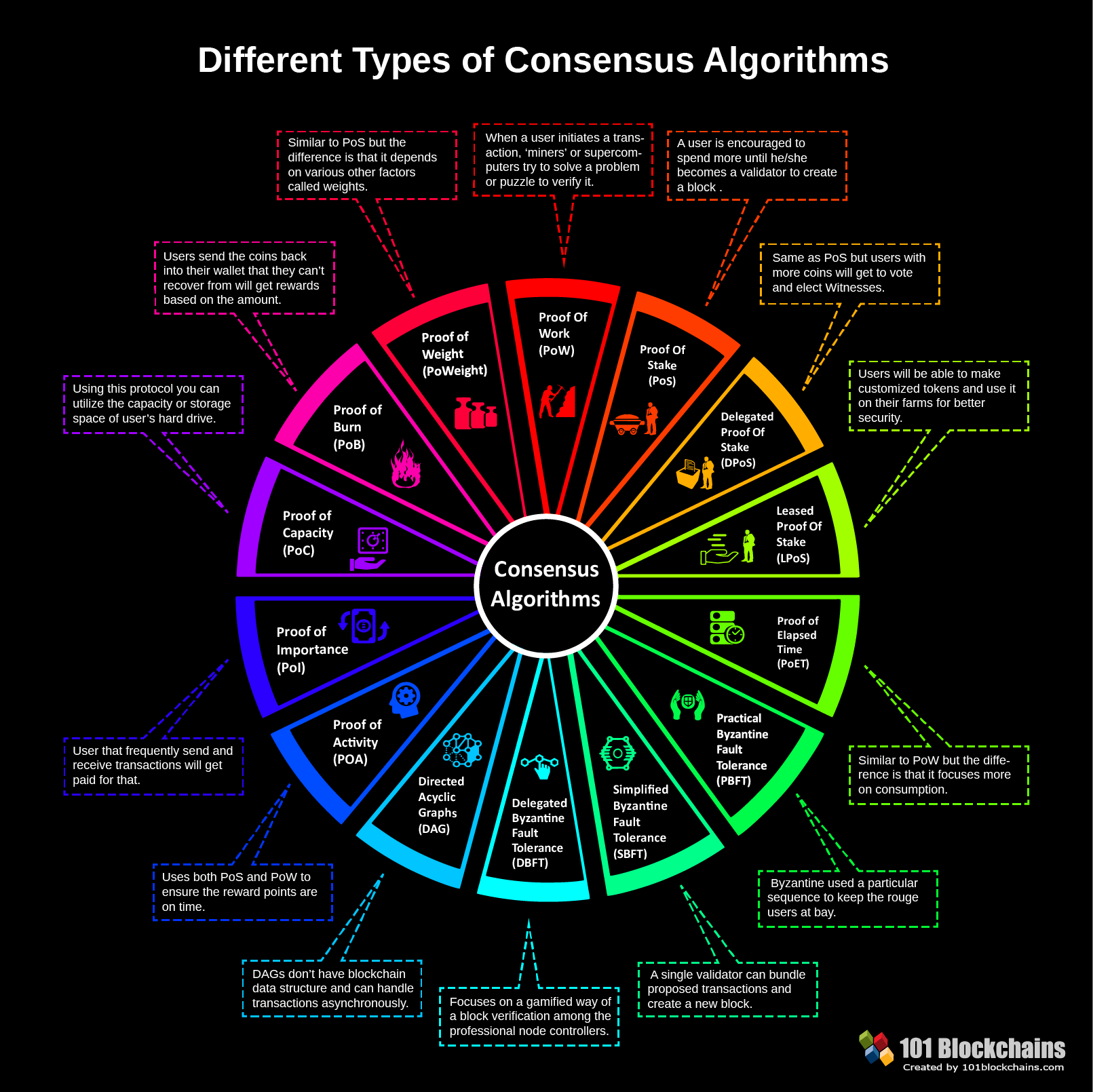
Please include attribution to 101blockchains.com with this graphic. <a href='https://101blockchains.com/blockchain-infographics/'> <img src='https://101blockchains.com/wp-content/uploads/2018/08/Different_Consensus_Algorithms.png' alt='Consensus Algorithms Infographic='0' /> </a>
Here are a few examples of popular consensus algorithms:
- Proof-of-Work(PoW)
- Proof-of-Capacity (PoC)
- Proof-of-Activity (PoA)
- Delegated Proof-of-Stake(DPoS)
- Proof-of-Stake(PoS)
- Proof-of-Authority
- Proof-of-Burn
- Proof-of-Weight
- Proof-of-Elapsed Time
How To Interview A Blockchain Developer?
If you are an HR professional or a person who has been given the responsibility to interview Blockchain Developers, then you can also take advantage of the interview question and answers that are provided in this document.
Apart from the content, you should also look for other aspects of the candidate such as Leadership skills, the ability to manage themselves, and the urge to learn new things.
In reality, doing a Blockchain Developer interview is not easy and you should take your time and prepare earlier!
Start learning Blockchain with World’s first Blockchain Career Paths with quality resources tailored by industry experts Now!
Conclusion
We hope you found this complete list of the most often-asked interview questions helpful. In reality, these Blockchain Developer interview questions should help you prepare for the Blockchain Developer interview. However, we still recommend that you brush up on the basics, as having a clear understanding of the core concepts will always give you an edge over your rival.
*Disclaimer: The article should not be taken as, and is not intended to provide any investment advice. Claims made in this article do not constitute investment advice and should not be taken as such. 101 Blockchains shall not be responsible for any loss sustained by any person who relies on this article. Do your own research!





